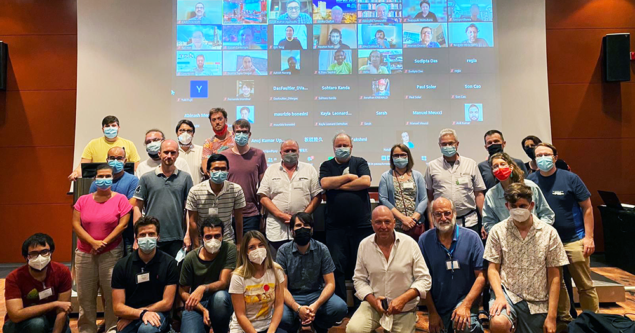
The 22nd International Workshop on Neutrinos from Accelerators (NuFact 2021) was held from 6 to 11 September, attracting a record 450 participants either online or in Cagliari, Italy. NuFact addresses topics in neutrino oscillations and neutrino-scattering physics, neutrino beams, muon physics, neutrinos beyond the Standard Model and the latest generation of neutrino detectors. The 2021 edition was organised by the Cagliari Division of INFN, the Italian Institute for Nuclear Physics and the University of Milano-Bicocca.
At the time of the first NuFact in 1999, it wasn’t at all clear that accelerator experiments could address leptonic CP violation in neutrinos. Fits still ignored θ13, which expresses the relatively small coupling between the third neutrino mass eigenstate and the electron, and the size of the solar-oscillation mass splitting, which drives the CP-violating amplitude. Today, leading experiments testify to a precision era of neutrino physics where every parameter in the neutrino mixing matrix must be fitted. TK2, NOvA and MINERvA all reported new analyses and speakers from Fermilab updated the conference on the commissioning of the laboratory’s short-baseline experiments ICARUS, MicroBooNE and SBND, which seek to clarify experimental hints of additional “sterile” neutrinos. After a long journey from CERN to Fermilab, the ICARUS detector, the largest and most downstream of the three liquid-argon detectors in the programme, has been filled with liquid argon, and data taking is now in full swing.
g-2 anomaly
As we strive to pin down the values of the neutrino mixing matrix with a precision approaching that of the CKM matrix, NuFact serves as a key forum for collaborations between theorists and experimentalists. Simon Corrodi (Argonne) showed how the latest results from Fermilab on the g-2 anomaly may suggest new physics in lepton couplings, with potential implications for neutrino couplings and neutrino propagation. Collaboration with accelerator physicists is also important. After the discovery in 2012 that θ13 is nonzero, the focus of experiments with artificial sources of neutrinos turned to the development of multi-MW beams and the need for new facilities. Keith Gollwitzer (Fermilab) kicked off the discussion by summarising Fermilab’s outstanding programme at the intensity frontier, paving the way for DUNE, and Megan Friend (KEK) presented impressive progress in Japan last year. The J-PARC accelerator complex is being upgraded to serve the new T2K near detector, for which the final TPC anode and cathode are now being tested at CERN. The J-PARC luminosity upgrade will also serve the Hyper-Kamiokande experiment, which is due to come online on approximately the same timeline as DUNE. Though the J-PARC neutrino beam will be less intense and by design more monochromatic than that from Fermilab to DUNE, the Hyper-Kamiokande detector will be both closer and larger, promising comparable statistics to DUNE, and addressing the same physics questions at a lower energy.
ENUBET and nuSTORM could operate in parallel with DUNE and Hyper-Kamiokande
A lively round-table discussion featured a dialogue between two of the experiments’ co-spokespersons, Stefan Söldner-Rembold (Manchester) and Francesca Di Lodovico (King’s College London). Both emphasised the complementarity of DUNE and Hyper-Kamiokande, and the need to reduce systematic uncertainties with ad-hoc experiments. J-PARC director Takahashi Kobayashi explored this point in the context of data-driven models and precision experiments such as ENUBET and nuSTORM. Both experiments are in the design phase, and could operate in parallel with DUNE and Hyper-Kamiokande in the latter half of this decade, said Sara Bolognesi (Saclay) and Kenneth Long (Imperial). A satellite workshop focused on potential synergies between these two CERN-based projects and a muon-collider demonstrator, while another workshop explored physics goals and technical challenges for “ESSnuSB” – a proposed neutrino beam at the European Spallation Source in Lund, Sweden. In a plenary talk, Nobel laureate and former CERN Director-General Carlo Rubbia went further still, exploring the possibility of a muon collider at the same facility.
The next NuFact will take place in August 2022 in Salt Lake City, Utah.








